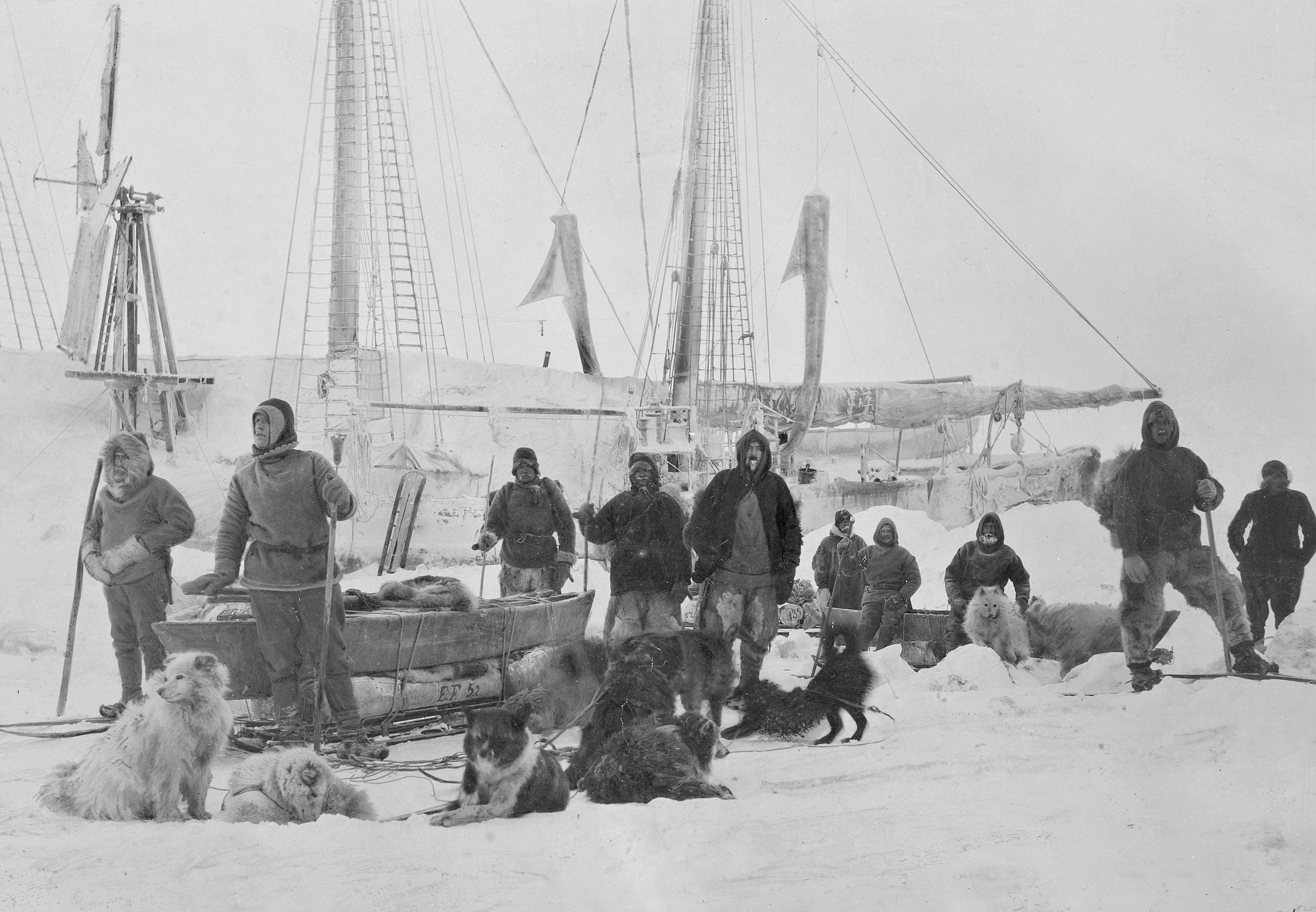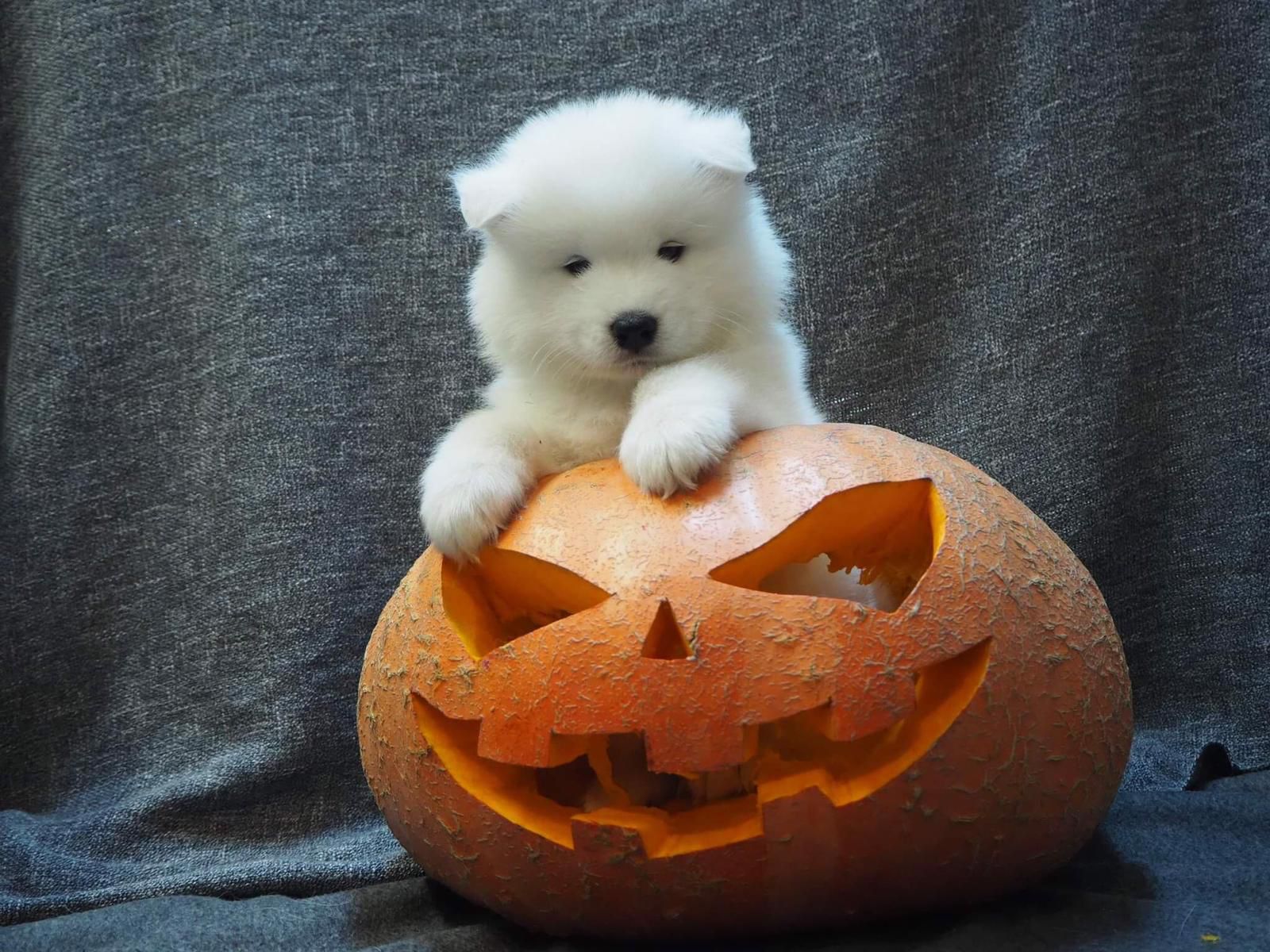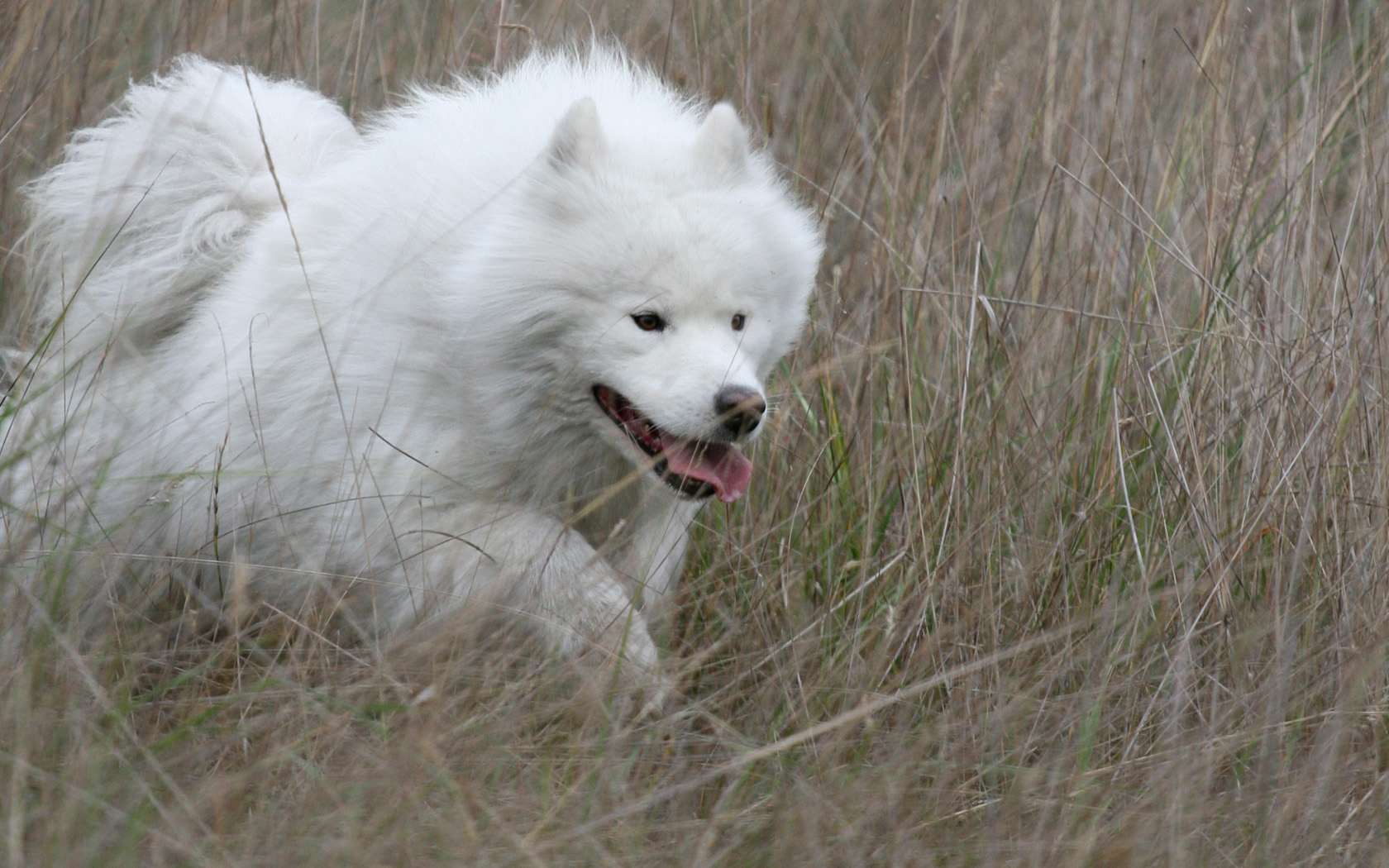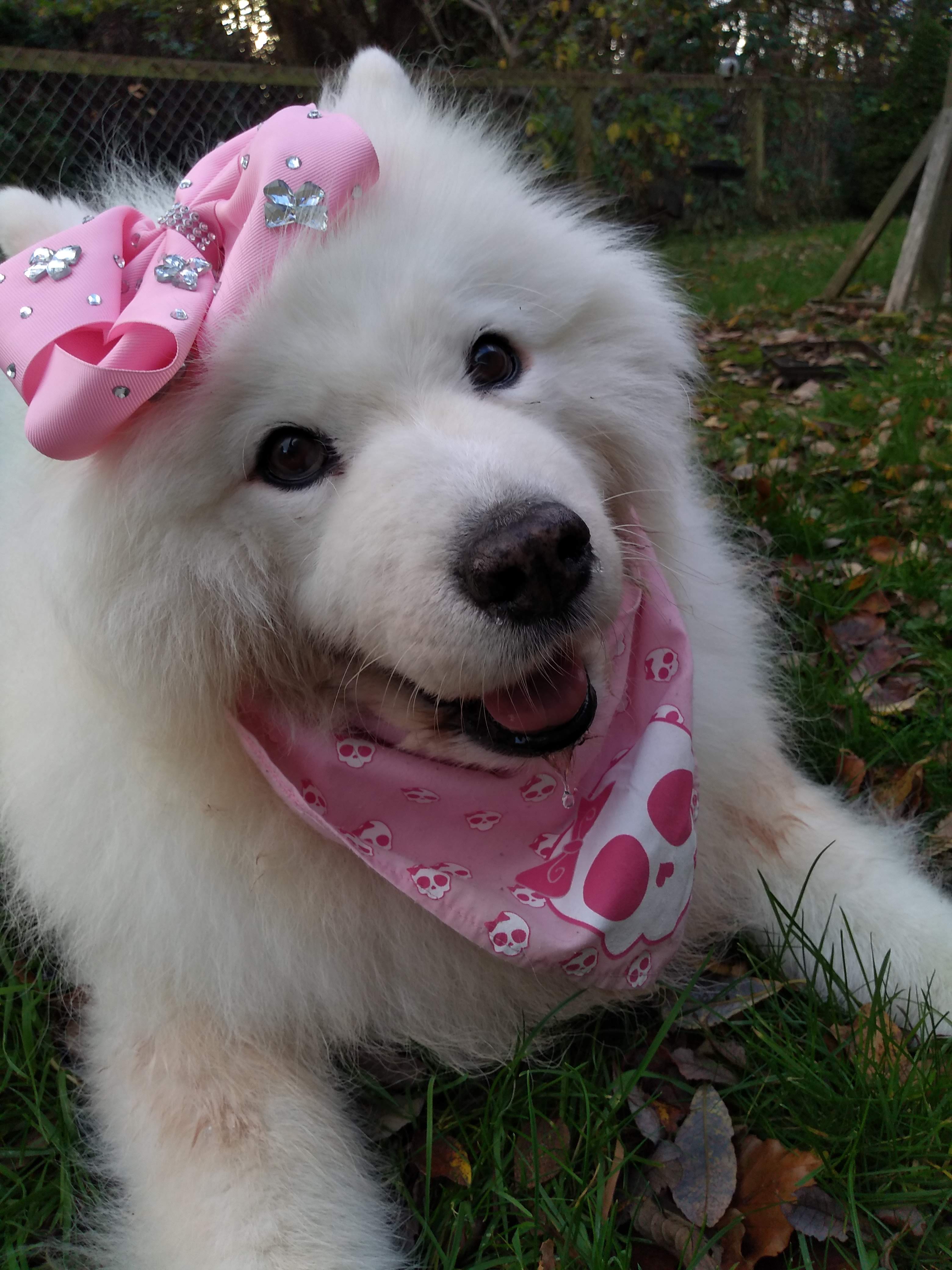Samoyed (dog) on:
[Wikipedia]
[Google]
[Amazon]
The Samoyed ( or ; russian: Самое́дская соба́ка or Самое́д) is a breed of medium-sized
 The progenitor of the Samoyeds was the
The progenitor of the Samoyeds was the  During preparation for the Fram expedition to the North Pole in 1893–1896, 33 dogs were purchased from the Nenets people. While 28 of these dogs would go to the North Pole, none of them survived. The remaining dogs, including pups born during the voyage, were left aboard the ship. In April of 1893 the bitch had another litter, most of them white. According to Nansen's notes "...all the dogs were strong, tough and excellent at pulling sleds; they worked very well in hunting Polar bears s well" These dogs would become the original Samoyeds.
During preparation for the Fram expedition to the North Pole in 1893–1896, 33 dogs were purchased from the Nenets people. While 28 of these dogs would go to the North Pole, none of them survived. The remaining dogs, including pups born during the voyage, were left aboard the ship. In April of 1893 the bitch had another litter, most of them white. According to Nansen's notes "...all the dogs were strong, tough and excellent at pulling sleds; they worked very well in hunting Polar bears s well" These dogs would become the original Samoyeds.
 The AKC Standard requires and at the shoulder for males, and and for females. The UK Kennel Club Standard requires for males, and for females.
Samoyed eyes are usually black or brown and are almond in shape. Samoyeds with eyes of other colors like blue exist but are not allowed in the show ring. The Samoyed is in the "brown and black section" in its family, the
The AKC Standard requires and at the shoulder for males, and and for females. The UK Kennel Club Standard requires for males, and for females.
Samoyed eyes are usually black or brown and are almond in shape. Samoyeds with eyes of other colors like blue exist but are not allowed in the show ring. The Samoyed is in the "brown and black section" in its family, the
 Samoyeds' friendly and affable disposition makes them poor guard dogs; an aggressive Samoyed is rare. The breed is characterized by an alert and happy expression which has earned the nicknames "Sammie smile" and "smiley dog". With their tendency to bark, however, they can be diligent watch dogs, barking whenever something approaches their territory. Samoyeds are excellent companions, especially for small children or even other dogs, and they remain playful into old age. According to the Samoyed Club of America, when Samoyeds become bored, they may become destructive or start to dig. With their
Samoyeds' friendly and affable disposition makes them poor guard dogs; an aggressive Samoyed is rare. The breed is characterized by an alert and happy expression which has earned the nicknames "Sammie smile" and "smiley dog". With their tendency to bark, however, they can be diligent watch dogs, barking whenever something approaches their territory. Samoyeds are excellent companions, especially for small children or even other dogs, and they remain playful into old age. According to the Samoyed Club of America, when Samoyeds become bored, they may become destructive or start to dig. With their
 Carrier females do develop mild symptoms after 2–3 months of age, but mostly do not go on to develop
Carrier females do develop mild symptoms after 2–3 months of age, but mostly do not go on to develop
herding dog
A herding dog, also known as a stock dog, shepherd dog, sheep dog or working dog, is a type of dog that either has been trained in herding or belongs to breeds that are developed for herding.
Herding behavior
All herding behavior is mo ...
s with thick, white, double-layer coats. They are a spitz-type dog which takes its name from the Samoyedic peoples of Siberia
Siberia ( ; rus, Сибирь, r=Sibir', p=sʲɪˈbʲirʲ, a=Ru-Сибирь.ogg) is an extensive region, geographical region, constituting all of North Asia, from the Ural Mountains in the west to the Pacific Ocean in the east. It has been a ...
. Descending from the Nenets Herding Laika
The Nenets Herding Laika (Russian: Ненецкая лайка) also known as the reindeer spitz, is an aboriginal spitz landrace of dog originating from the Yamalo-Nenets Autonomous Okrug, in Russia. Unlike other laikas, Nenets Herding Laika ar ...
, they are a domesticated animal that assists in herding, hunting
Hunting is the human practice of seeking, pursuing, capturing, or killing wildlife or feral animals. The most common reasons for humans to hunt are to harvest food (i.e. meat) and useful animal products ( fur/ hide, bone/tusks, horn/antler, ...
, protection and sled-pulling.
Samoyed dogs are most often white, and can have a brown tint to their double-layer coat which is naturally dirt repellent. They are known to be used in expeditions in both Arctic
The Arctic ( or ) is a polar region located at the northernmost part of Earth. The Arctic consists of the Arctic Ocean, adjacent seas, and parts of Canada (Yukon, Northwest Territories, Nunavut), Danish Realm (Greenland), Finland, Iceland, N ...
and Antarctic regions and have a friendly and agreeable disposition.
Lineage
Nenets Herding Laika
The Nenets Herding Laika (Russian: Ненецкая лайка) also known as the reindeer spitz, is an aboriginal spitz landrace of dog originating from the Yamalo-Nenets Autonomous Okrug, in Russia. Unlike other laikas, Nenets Herding Laika ar ...
, a reindeer herding spitz commonly used throughout northern Siberia, especially the Nenets people who were pejoratively referred to as Samoyeds at that time. DNA evidence confirms that Samoyeds are a basal breed that predates the emergence of the modern breeds in the 19th century. A genomic study of two dog specimens that are nearly 100 years old and obtained from the Nenets people
The Nenets ( yrk, ненэй ненэче, ''nenəj nenəče'', russian: ненцы, ''nentsy''), also known as Samoyed, are a Samoyedic ethnic group native to northern Arctic Russia, Russian Far North. According to the latest census in 2010, t ...
on the Yamal Peninsula
The Yamal Peninsula (russian: полуостров Ямал, poluostrov Yamal) is located in the Yamalo-Nenets Autonomous Okrug of northwest Siberia, Russia. It extends roughly 700 km (435 mi) and is bordered principally by the Kara ...
found that these are related to two specimens dated 2,000 years old and 850 years old, which suggests continuity of the lineage in this region. The two 100 year old dogs were closely related with the Samoyed breed, which indicates that the ancient arctic lineage lives on in the modern Samoyed dog.
 During preparation for the Fram expedition to the North Pole in 1893–1896, 33 dogs were purchased from the Nenets people. While 28 of these dogs would go to the North Pole, none of them survived. The remaining dogs, including pups born during the voyage, were left aboard the ship. In April of 1893 the bitch had another litter, most of them white. According to Nansen's notes "...all the dogs were strong, tough and excellent at pulling sleds; they worked very well in hunting Polar bears s well" These dogs would become the original Samoyeds.
During preparation for the Fram expedition to the North Pole in 1893–1896, 33 dogs were purchased from the Nenets people. While 28 of these dogs would go to the North Pole, none of them survived. The remaining dogs, including pups born during the voyage, were left aboard the ship. In April of 1893 the bitch had another litter, most of them white. According to Nansen's notes "...all the dogs were strong, tough and excellent at pulling sleds; they worked very well in hunting Polar bears s well" These dogs would become the original Samoyeds.
Appearance and characteristics
 The AKC Standard requires and at the shoulder for males, and and for females. The UK Kennel Club Standard requires for males, and for females.
Samoyed eyes are usually black or brown and are almond in shape. Samoyeds with eyes of other colors like blue exist but are not allowed in the show ring. The Samoyed is in the "brown and black section" in its family, the
The AKC Standard requires and at the shoulder for males, and and for females. The UK Kennel Club Standard requires for males, and for females.
Samoyed eyes are usually black or brown and are almond in shape. Samoyeds with eyes of other colors like blue exist but are not allowed in the show ring. The Samoyed is in the "brown and black section" in its family, the Spitz
Spitz (derived from the German word ''spitz'' 'pointed') is a type of domestic dog characterized by long, thick, and often white fur, and pointed ears and muzzles. The tail often curls over the dog's back or droops. While all of the breeds rese ...
family.
Samoyed ears are thick and covered with fur, triangular in shape, and erect. They are almost always white but have a light to dark brown tint (known as "biscuit") to a greater or lesser extent. The tint is usually on the ears but can be visible on the whole body.
The Samoyed tail is one of the breed's distinguishing features. Like the Alaskan Malamute, the tail is carried curled over the back; however, unlike the Alaskan Malamute, the Samoyed tail is held actually touching the back. It is not usually held in a tight curl, or held flag-like; it is usually carried lying over the back and to one side. In cold weather, Samoyeds may sleep with their tails over their noses to provide additional warmth. Almost all Samoyeds will allow their tails to fall when they are relaxed and at ease, as when being stroked or while eating, but will return their tails to a curl when more alert.
Samoyeds have a dense, double layer coat. The topcoat contains long, coarse, and straight guard hair
Guard hair or overhair is the outer layer of hair of most mammals, which overlay the fur. Guard hairs are long and coarse and protect the rest of the pelage (fur) from abrasion and frequently from moisture. They are visible on the surface of the fu ...
s, which appear white but have a hint of silver coloring. This top layer keeps the undercoat relatively clean and free of debris. The under layer, or undercoat, consists of a dense, soft, and short fur that keeps the dog warm. The undercoat typically sheds heavily once or twice a year, and this seasonal process is sometimes referred to as "blowing coat". This does not mean the Samoyed will shed only during that time however; fine hairs (versus the dense clumps shed during seasonal shedding) will be shed all year round, and have a tendency to stick to cloth and float in the air. The standard Samoyed may come in a mixture of biscuit and white coloring, although pure white and all biscuit dogs are common. Males typically have larger ruffs than females. While this breed is touted as "hypoallergenic", it does shed a fair amount and needs frequent grooming. While the breed may produce fewer allergens, care should be taken for severe allergies.
Shed Samoyed fur is sometimes used as an alternative to wool in knitting, with a texture similar to angora. The fur is sometimes also used for the creation of artificial flies
An artificial fly or fly lure is a type of fishing lure, usually used in the sport of fly fishing (although they may also be used in other forms of angling). In general, artificial flies are an imitation of aquatic insects that are natural food of ...
for fly fishing.
Life expectancy for the breed is about 12–13 years.
Temperament
 Samoyeds' friendly and affable disposition makes them poor guard dogs; an aggressive Samoyed is rare. The breed is characterized by an alert and happy expression which has earned the nicknames "Sammie smile" and "smiley dog". With their tendency to bark, however, they can be diligent watch dogs, barking whenever something approaches their territory. Samoyeds are excellent companions, especially for small children or even other dogs, and they remain playful into old age. According to the Samoyed Club of America, when Samoyeds become bored, they may become destructive or start to dig. With their
Samoyeds' friendly and affable disposition makes them poor guard dogs; an aggressive Samoyed is rare. The breed is characterized by an alert and happy expression which has earned the nicknames "Sammie smile" and "smiley dog". With their tendency to bark, however, they can be diligent watch dogs, barking whenever something approaches their territory. Samoyeds are excellent companions, especially for small children or even other dogs, and they remain playful into old age. According to the Samoyed Club of America, when Samoyeds become bored, they may become destructive or start to dig. With their sled dog
A sled dog is a dog trained and used to pull a land vehicle in harness, most commonly a sled over snow.
Sled dogs have been used in the Arctic for at least 8,000 years and, along with watercraft, were the only transportation in Arctic areas ...
heritage, a Samoyed is not averse to pulling things, and an untrained Samoyed has no problem pulling its owner on a leash rather than walking alongside.
Activities
Samoyeds can compete in dog agility trials,carting
Carting is a dog sport or activity in which a dog (usually a large breed) pulls a dogcart filled with supplies, such as farm goods, camping equipment, groceries or firewood, but sometimes pulling people. Carting as a sport is also known as dry ...
, obedience, showmanship, flyball, tracking, mushing
Mushing is a sport or transport method powered by dogs. It includes carting, pulka, dog scootering, sled dog racing, skijoring, freighting, and weight pulling. More specifically, it implies the use of one or more dogs to pull a sled, most com ...
and herding
Herding is the act of bringing individual animals together into a group (herd), maintaining the group, and moving the group from place to place—or any combination of those. Herding can refer either to the process of animals forming herds in ...
events. Herding
Herding is the act of bringing individual animals together into a group (herd), maintaining the group, and moving the group from place to place—or any combination of those. Herding can refer either to the process of animals forming herds in ...
instincts and trainability can be measured at non-competitive herding tests. Samoyeds exhibiting basic herding instincts can be trained to compete in herding trials.
Health
Samoyed hereditary glomerulopathy
The breed can be affected by a genetic disease known as Samoyed hereditary glomerulopathy, akidney
The kidneys are two reddish-brown bean-shaped organs found in vertebrates. They are located on the left and right in the retroperitoneal space, and in adult humans are about in length. They receive blood from the paired renal arteries; blo ...
disease. The disease is known to be caused by an X-linked
Sex linked describes the sex-specific patterns of inheritance and presentation when a gene mutation (allele) is present on a sex chromosome (allosome) rather than a non-sex chromosome (autosome). In humans, these are termed X-linked recessive, ...
dominant faulty allele
An allele (, ; ; modern formation from Greek ἄλλος ''állos'', "other") is a variation of the same sequence of nucleotides at the same place on a long DNA molecule, as described in leading textbooks on genetics and evolution.
::"The chro ...
and therefore the disease is more severe in male Samoyeds. Also known as hereditary nephritis, it is caused by a nonsense mutation
In genetics, a nonsense mutation is a point mutation in a sequence of DNA that results in a premature stop codon, or a ''nonsense codon'' in the transcribed mRNA, and in leading to a truncated, incomplete, and usually nonfunctional protein produc ...
in codon 1027 of the COL4A5 gene on the X chromosome
The X chromosome is one of the two sex-determining chromosomes (allosomes) in many organisms, including mammals (the other is the Y chromosome), and is found in both males and females. It is a part of the XY sex-determination system and XO sex ...
(glycine
Glycine (symbol Gly or G; ) is an amino acid that has a single hydrogen atom as its side chain. It is the simplest stable amino acid ( carbamic acid is unstable), with the chemical formula NH2‐ CH2‐ COOH. Glycine is one of the proteinog ...
to stop codon
In molecular biology (specifically protein biosynthesis), a stop codon (or termination codon) is a codon (nucleotide triplet within messenger RNA) that signals the termination of the translation process of the current protein. Most codons in mess ...
), which is similar to Alport's syndrome in humans.
 Carrier females do develop mild symptoms after 2–3 months of age, but mostly do not go on to develop
Carrier females do develop mild symptoms after 2–3 months of age, but mostly do not go on to develop kidney failure
Kidney failure, also known as end-stage kidney disease, is a medical condition in which the kidneys can no longer adequately filter waste products from the blood, functioning at less than 15% of normal levels. Kidney failure is classified as eit ...
. The disease is caused by a defect in the structure of the type-IV collagen fibrils of the glomerular basement membrane. As a consequence, the collagen fibrils of the glomerular basement membrane are unable to form cross-links, so the structural integrity is weakened and the membrane is more susceptible to "wear-and-tear" damage. As the structure of the basement membrane begins to degenerate, plasma proteins are lost in the urine and symptoms begin to appear. Affected males appear healthy for the first three months of life, but then symptoms start to appear and worsen as the disease progresses: the dog becomes lethargic and muscle wastage occurs, as a result of proteinuria
Proteinuria is the presence of excess proteins in the urine. In healthy persons, urine contains very little protein; an excess is suggestive of illness. Excess protein in the urine often causes the urine to become foamy (although this symptom ma ...
. From three months of age onwards, a reduced glomerular filtration rate
Renal functions include maintaining an acid–base balance; regulating fluid balance; regulating sodium, potassium, and other electrolytes; clearing toxins; absorption of glucose, amino acids, and other small molecules; regulation of blood pre ...
is detected, indicative of progressive kidney failure.
Clinically, proteinuria
Proteinuria is the presence of excess proteins in the urine. In healthy persons, urine contains very little protein; an excess is suggestive of illness. Excess protein in the urine often causes the urine to become foamy (although this symptom ma ...
is found in both sexes from the age of three to four months; in dogs older than this, kidney failure in combination with more or less pronounced hearing loss occurs swiftly and death at the age of 8 to 15 months is expected. In heterozygous
Zygosity (the noun, zygote, is from the Greek "yoked," from "yoke") () is the degree to which both copies of a chromosome or gene have the same genetic sequence. In other words, it is the degree of similarity of the alleles in an organism.
Mo ...
females, the disease develops slowly. The disease can be treated to slow down the development by use of cyclosporine A and ACE inhibitors, but not be stopped.
If a carrier female is mated with a healthy stud dog, the female offspring have a 50% chance of being carriers for the disease, and any male offspring have a 50% chance of being affected by the disease. A genetic test is available for this disease.
Other health concerns
For the Samoyeds several breed-specific hereditary diseases are described in the veterinary literature: *Diabetes mellitus
Diabetes, also known as diabetes mellitus, is a group of metabolic disorders characterized by a high blood sugar level ( hyperglycemia) over a prolonged period of time. Symptoms often include frequent urination, increased thirst and increased ...
similar but not identical to human Type I (insulin deficiency): The disease occurs in middle-aged Samoyeds, the mean age at diagnosis is seven years. The cause is a chronic inflammation of the pancreas
The pancreas is an organ of the digestive system and endocrine system of vertebrates. In humans, it is located in the abdomen behind the stomach and functions as a gland. The pancreas is a mixed or heterocrine gland, i.e. it has both an en ...
and/or autoimmune
In immunology, autoimmunity is the system of immune responses of an organism against its own healthy cells, tissues and other normal body constituents. Any disease resulting from this type of immune response is termed an "autoimmune disease". ...
destruction of beta cells of islets of Langerhans
The pancreatic islets or islets of Langerhans are the regions of the pancreas that contain its endocrine (hormone-producing) cells, discovered in 1869 by German pathological anatomist Paul Langerhans. The pancreatic islets constitute 1–2% of ...
. Moreover, autoantibodies to insulin were found in affected dogs. Several genetic markers are being discussed as possible causes.
* Progressive retinal atrophy (PRA) caused by a frameshift mutation in the RPRG locus of the X chromosome. The disease leads to a slowly progressive loss of vision, which eventually leads to blindness. The first symptoms appear between two and five years of age. The disease corresponds to the X-linked PRA type 3 in humans.
* Short legs in conjunction with eye abnormalities: a genetic defect at the COL2A1 locusleads to disproportionate dwarfism due to short limbs in connection with cataracts, malformations of the retina and / or retinal detachment, liquefaction of the vitreous and a persistent hyaloid artery. The malformations of the retina are dominant (i.e. they occur in heterozygous dogs); the other symptoms are recessive, so they only come to expression in homozygous dogs. These conditions have no effect on the expression of the protein opticin.
* Pulmonary stenosis occurs more frequently in Samoyeds in comparison with other breeds. The disease can cause shortness of breath, cardiac arrhythmias and rapid fatigue when moving, and increases the risk of congestive heart failure.
* Hip dysplasia
Hip dysplasia is an abnormality of the hip joint where the socket portion does not fully cover the ball portion, resulting in an increased risk for joint dislocation. Hip dysplasia may occur at birth or develop in early life. Regardless, it doe ...
is also a concern for Samoyeds.
* The breed can also be affected by sebaceous adenitis
Sebaceous adenitis in an uncommon skin disease found in some breeds of dog, and more rarely in cats, rabbits and horses. characterised by an inflammatory response against the dog's sebaceous glands (glands found in the hair follicles in the skin ...
, an uncommon idiopathic
An idiopathic disease is any disease with an unknown cause or mechanism of apparent spontaneous origin. From Greek ἴδιος ''idios'' "one's own" and πάθος ''pathos'' "suffering", ''idiopathy'' means approximately "a disease of its own kin ...
autoimmune skin disease.
See also
* List of dog breedsReferences
Further reading
* * *External links
* {{Authority control Breeds originating from Indigenous people FCI breeds Sled dogs Spitz breeds Wool animals